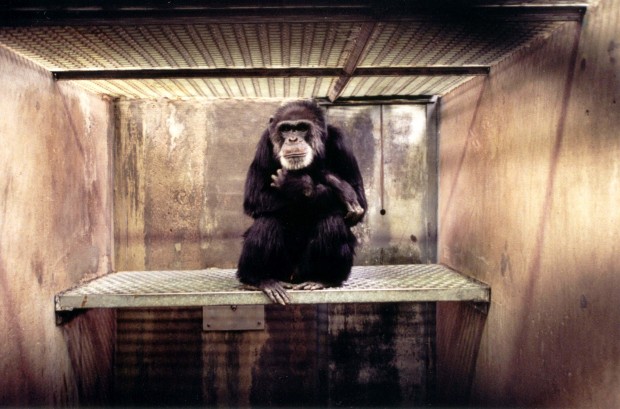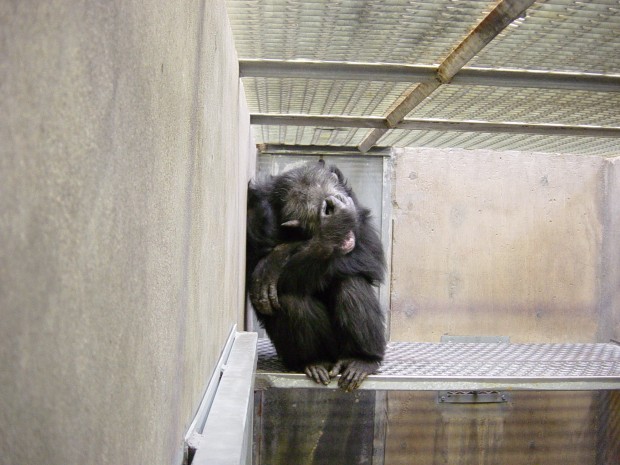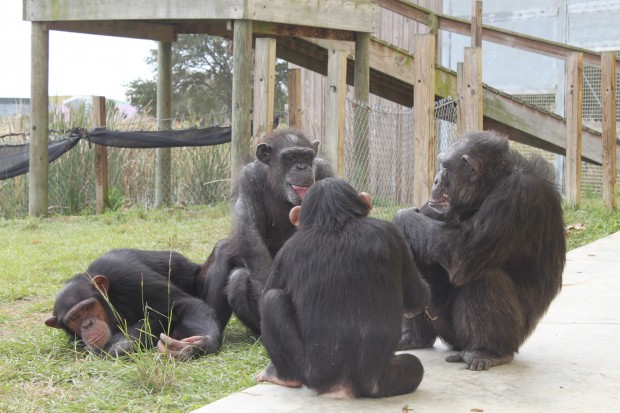Stacy Lopresti-Goodman, a psychologist the Marymount University in Arlington, Virginia, studies individuals who have lived in solitary confinement, and who suffer from posttraumatic stress disorder. But these individuals aren’t human – they’re chimpanzees who lived in biomedical research facilities.
One focus of Lopresti-Goodman’s research is trans-species psychology. Researchers in this field find commonalities between the cognitive processes and emotional responses in humans and animals. And since humans and chimps share 97% of their genetic material, they have many surprising similarities. Trans-species psychologists have found that both humans and chimpanzees who have experienced torture and isolation are unable to socialize normally, and suffer from depression and mood disorders.
“The symptoms that chimpanzees develop are very similar to prisoners of war and people who live in solitary confinement,” she says. “It’s common to keep them in these five-by-five-by-seven-foot cages. So spread your arms out and that’s how much space they have.”
The chimps live isolated in cages because they often carry one or more infectious diseases. Scientists routinely inject them with Hepatitis C, HIV, and malaria to test drugs and develop vaccines. Chimps can live to be 60, and some spend their entire lives encaged in concrete and steel.
Like humans, chimps are highly intelligent and social animals. Living in isolation and undergoing invasive medical procedures cause strange, antisocial behavior, like smearing their feces around their cages, and tearing at their hair and skin. Many lab chimps will clasp their shoulders and rock to sooth themselves.
The United States is the only country in the world that still allows chimpanzee research, but the social acceptance of experimenting on humans’ closest relative has declined sharply in recent years. In June of 2013, the National Institutes of Health announced that it would retire 310 of its remaining 360 chimps, and would no longer breed chimpanzees for research. In late November, President Obama signed legislation to greenlight the movement of the animals to a sanctuary, such as the federally funded Chimp Haven, in Keithville, Louisiana. Housing the chimps in a sanctuary instead of a lab will save U.S. taxpayers between $2.1 and $3.2 million per year.
At the end of January, the drug manufacturer, Merck & Co., announced that it would no longer use chimps to test drugs. They had used the animals primarily to test Hepatitis C treatments.
The largest chimpanzee sanctuary is Save the Chimps, in Fort Pierce, Florida. The facility is home to 266 chimps, with 253 that formerly underwent research in labs funded by the Centers for Disease Control and the National Institutes of Health. They live on 12 artificial islands surrounded by moats (because they can’t swim, the moats prevent escape) and can spend their days climbing and socializing.
Lopresti-Goodman visited Save the Chimps to see if the retired animals suffer long-lasting effects from their time in the labs. She interviewed the caregivers and veterinarians at the sanctuary about the chimps’ behavior. She found that 24% of the former lab animals had problems interacting with other chimpanzees, were hyper-reactive and easily angered or startled, or had a fear of the outdoors.
She focused on one retired chimp, named Seve, and observed him during his first year at the sanctuary to to see how he adjusted. A Freedom of Information Act request yielded his medical records and she found that he had been born in Alamogordo, New Mexico in 1993. He lived at the now-defunct Coulston Foundation. The lab facility declared bankruptcy in 2002 when it lost all of its government contracts due to multiple animal welfare violations.
At the age of two, Seve began his first NIH study where scientists infected him with Respiratory Syncytial Virus. He experienced daily throat swabs and frequent blood draws, which required him to be unconscious.
“Within seven months, he had 39 ‘knockdowns’ with an anesthesia dart gun,” Lopresti-Goodman says. “They came in wearing their biohazard suits and shot him to tranquilize him.”
Then in 1995, scientists infected Seve with Hepatitis C as part of a CDC study. Researchers removed half of his liver and his auxiliary lymph nodes. “He turned blue four times on the operating table – four different occasions – when they were performing liver biopsies,” she says. The records also indicate that he built up a tolerance to the anesthesia from the frequent surgeries so he required increasingly higher doses to knock him out. “They were still performing the surgery on him while he was semi-conscious.”
His CDC records indicate that in 2001, he began to injure himself. “He would just have these screaming fits and would just start clawing at his head and the back of his neck,” says Lopresti-Goodman.
The Save the Chimps sanctuary took over the chimps at the Coulston Foundation in 2002, but it took several years to transport all of the animals cross-country to their new home in Florida. Seve finally made the trip in 2011.
When Lopresti-Goodman first examined Seve at the sanctuary, she determined that the isolation and medical experiments had left him suffering from posttraumatic stress disorder. Three times during that first year she watched him for 11 hours over the course of a week and every minute would record his activities. She noted whether he hid in his enclosure or played with other chimps, and if he was acting normally or pulling his hair, rocking or screaming.
During the first observation week he spent 90 percent of his time alone. Seve would peak outside his enclosure, but rarely leave, and 10 percent of the time she saw him injuring himself. But a year later, Seve was spending more than half of his time outside, engaging with other chimps. His self-harming behavior also dropped down to one percent. Just being free to interact with other chimps in an open environment had improved his symptoms of PTSD.
As expensive and ethically troubling chimpanzee research is phased out, Lopresti-Goodman hopes that her work will convince people that these retired chimpanzees should be moved to legitimate sanctuaries, instead of warehoused in laboratories for their remaining decades.
“I hope that my results show that it is harmful and that they suffer similarly to humans,” she says.
She estimates that about 1,000 chimps still live in private and public biomedical labs across the U.S.




Insightful article! Hopefully increasing knowledge leads us to increased actions. Thanks so much for researching this.
Thank you for your excellent article. I am so glad to learn about your work, and am glad to hear about some of the improvements in the living situations of chimpanzees and other primates who have been used in animal testing. You make a very valid point that chimpanzees have a long life span, and need care throughout that lifetime.